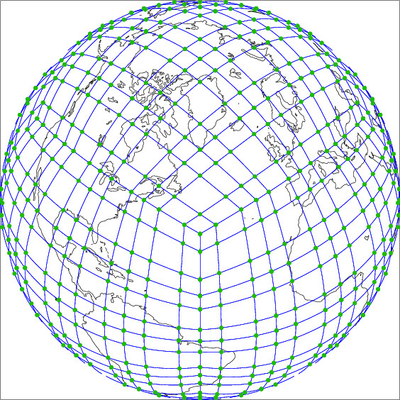...
Most analysis tools and other tools can not handle higher order elements such as used in CAM-SE. For these codes, we produce metadata that divide each spectral element into subcells. This subcell grid is shown below. The GLL nodes are the vertices of the subcell grid. This meta data can be used by Paraview and Visit to plot native grid CAM-SE output. The metadata is stored in a grid template file that typically has a file name of the form "<gridname>_latlon_<date>.nc" in the grids directory of the ACME inputdata server. From Euler's polyhedron formula, we know if there are N physics columns (GLL nodes), there will be N-2 subcells (all quads) and N/2-1 subcell edges.
SE "dual" grid
To remap data from the SE grid to other grids, ACME relies on ESMF mapping utilities. ESMF's conservative remapping algorithm can currently only map cell centered data. For every point in the mesh, ESMF treats that point as a cell average value, and requires that we specify its cell boundaries as a polygon. These polygons are the dual grid to the SE subcell grid. The metadata is stored in a grid template file in "SCRIP" format, that typically has a file name of the form "<gridname>_scrip-<date>.nc" in the grids directory of the ACME inputdata server. From Euler's polyhedron formula, we know if there are N physiccs columns (GLL nodes), there will be N-2 subcells with N/2-1 edges.
For conservative remapping, the areas of these polygons must match the weight of each GLL node. If we construct this dual grid in the usual way, by connecting the centers of all the subcells shown in the subcell grid, the areas of the cells will in general not match the GLL weights. We thus have to perform an iteration, similar to spring dynamics, tweaking the polygons until the areas are correct. We have a couple of algorithms to do this, but the resulting polygons can be a little odd. The result of one of these algorithms is shown below. For this figure, we have allowed pentagons and hexagons so that the algorithm will converge faster and to more uniform cells, but this means that some of them will be slightly non-convex. ESMF can handle non-convex cells, but other utilities may require they be convex.
...
